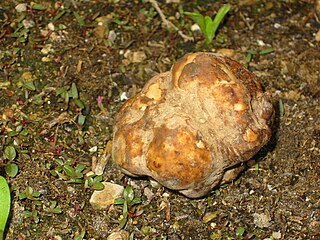
A truffle is the fruiting body of a subterranean ascomycete fungus, one of the species of the genus Tuber. More than one hundred other genera of fungi are classified as truffles including Geopora, Peziza, Choiromyces, and Leucangium. These genera belong to the class Pezizomycetes and the Pezizales order. Several truffle-like basidiomycetes are excluded from Pezizales, including Rhizopogon and Glomus. Truffles are ectomycorrhizal fungi, so they are found in close association with tree roots. Spore dispersal is accomplished through fungivores, animals that eat fungi. These fungi have ecological roles in nutrient cycling and drought tolerance.

Terfezia is a genus of truffle-like fungi within the Pezizaceae family. Terfezia species are commonly known as desert truffles. Some authorities consider this the type genus of the family Terfeziaceae, although phylogenetic analysis suggests that it nests within the Pezizaceae. The Dictionary of the Fungi suggests that the genus contains 12 species. A recent (2011) publication used molecular analysis to show that the American Terfezia species had been incorrectly classified, and moved Terfezia spinosa and Terfezia longii to Mattirolomyces and Stouffera, respectively; as a result, no Terfezia species are known to exist in North America.

Weraroa was a genus of mushrooms from the families Hymenogastraceae and Strophariaceae. The genus was initially described by mycologist Rolf Singer in 1958 to accommodate the single species Secotium novae-zelandiae reported by Gordon Herriott Cunningham in 1924. It was thought that the genus represented an intermediary evolutionary stage between a hypogeous (underground) ancestor and the related epigeous genus Stropharia. Advances in phylogenetics and taxonomic changes since 1958 found it contained unrelated species from multiple genera. It is now considered a synonym of the genus Psilocybe.

Bovista is a genus of fungi commonly known as the true puffballs. It was formerly classified within the now-obsolete order Lycoperdales, which, following a restructuring of fungal taxonomy brought about by molecular phylogeny, has been split; the species of Bovista are now placed in the family Agaricaceae of the order Agaricales. Bovista species have a collectively widespread distribution, and are found largely in temperate regions of the world. Various species have historically been used in homeopathic preparations.

The Meripilaceae are a family of fungi in the order Polyporales. The family was circumscribed by Swiss mycologist Walter Jülich in 1982 with Meripilus as the type genus. A 2008 estimate placed 7 genera and 57 species in Meripilaceae. As of April 2018, Index Fungorum accepts 74 species in the family.

Ceriporia is a widely distributed genus of crust fungi.

Ruhlandiella is a genus of fungi within the family Pezizaceae. Ruhlandiella species are exothecial hypogeous fungi, which are essentially truffles that lack the outer layer or peridium. Ruhlandiella species are widely distributed in Nothofagaceae forests in South America and near Eucalyptus or Melaleuca plants in Australia, North America, and Europe.

Disciseda is a genus of gasteroid fungi in the family Agaricaceae. It is a widely distributed genus that is prevalent in arid zones. Disciseda was circumscribed by mycologist Vassiliĭ Matveievitch Czernajew in 1845.

Lycoperdon echinatum, commonly known as the spiny puffball or the spring puffball, is a type of puffball mushroom in the family Agaricaceae. The saprobic species has been found in Africa, Europe, Central America, and North America, where it grows on soil in deciduous woods, glades, and pastures. It has been proposed that North American specimens be considered a separate species, Lycoperdon americanum, but this suggestion has not been followed by most authors. Molecular analysis indicates that L. echinatum is closely related to the puffball genus Handkea.

The gasteroid fungi are a group of fungi in the Basidiomycota. Species were formerly placed in the obsolete class Gasteromycetes Fr., or the equally obsolete order Gasteromycetales Rea, because they produce spores inside their basidiocarps rather than on an outer surface. However, the class is polyphyletic, as such species—which include puffballs, earthballs, earthstars, stinkhorns, bird's nest fungi, and false truffles—are not closely related to each other. Because they are often studied as a group, it has been convenient to retain the informal (non-taxonomic) name of "gasteroid fungi".

Austropaxillus is a genus of fungi in the family Serpulaceae, containing nine species found in Australia, New Zealand and South America.
Dingleya is a genus of truffles in the Tuberaceae family. The genus contains seven species found in Australia. Circumscribed by James Trappe in 1979, the genus is named after New Zealand mycologist Joan Dingley.
Malajczukia is a genus of truffle-like fungi in the Mesophelliaceae family. The genus contains eight species found in Australia and New Zealand.

Claustula is a fungal genus in the family Claustulaceae. It is monotypic, containing the single truffle-like species Claustula fischeri, described in 1926 and found in New Zealand and Tasmania. In May 2016, it was one of two native New Zealand fungi added to the IUCN Red List of Threatened Species as endangered.

Tolypocladium ophioglossoides, also known by two of its better known synonyms Elaphocordyceps ophioglossoides and Cordyceps ophioglossoides and commonly known as the goldenthread cordyceps, is a species of fungus in the family Ophiocordycipitaceae. It is parasitic on fruit bodies of the truffle-like Elaphomyces. The species is considered inedible, but is valued in traditional Chinese medicine.

Solenopsora is a genus of lichen-forming fungi in the family Catillariaceae. It has 15 species, with a mostly Northern Hemisphere distribution.

Schaereria is a genus of lichen-forming fungi. It is the sole genus in the family Schaereriaceae, which itself is the only family in the Schaereriales, an order in the subclass Ostropomycetidae of the class Lecanoromycetes. Most Schaereria species are crustose lichens that live on rocks. Schaereria was first proposed by Gustav Wilhelm Körber in 1855 and was later taken up by other lichenologists despite periods of disuse.

Paurocotylis pila, commonly known as the scarlet berry truffle, is an ascomycete fungus in the genus Paurocotylis. It was first described by Miles Joseph Berkley in 1855.
















